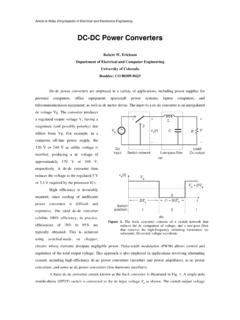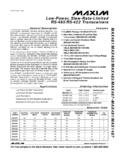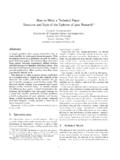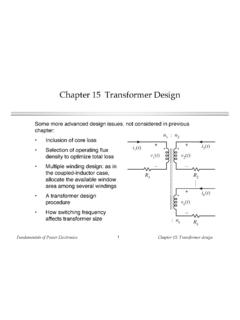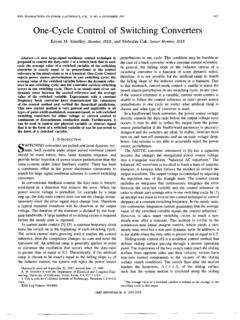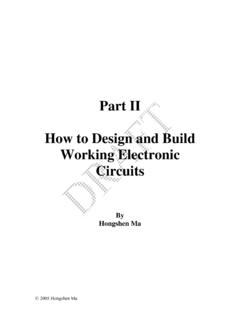Transcription of Chapter 12 Current Programmed Control
1 Fundamentals of power Electronics1 Chapter 12: Current Programmed ControlChapter 12 Current Programmed Control + Buck converterCurrent- Programmed controllerRvg(t)is(t)+v(t) iL(t)Q1 LCD1+ AnalogcomparatorLatchTs0 SRQC lockis(t)RfMeasureswitchcurrentis(t)RfCo ntrolinputic(t)Rf +vrefv(t)CompensatorConventional output voltage controllerSwitchcurrentis(t) Control signalic(t)m1t0dTsTsonoffTransistorstatu s:Clock turnstransistor onComparator turnstransistor offThe peak transistor currentreplaces the duty cycle as theconverter Control of power Electronics2 Chapter 12: Current Programmed ControlCurrent Programmed Control vs. duty cycle controlAdvantages of Current Programmed Control : Simpler dynamics inductor pole is moved to high frequency Simple robust output voltage Control , with large phase margin,can be obtained without use of compensator lead networks It is always necessary to sense the transistor Current , to protectagainst overcurrent failures.
2 We may as well use theinformation during normal operation, to obtain better Control Transistor failures due to excessive Current can be preventedsimply by limiting ic(t) Transformer saturation problems in bridge or push-pullconverters can be mitigatedA disadvantage: susceptibility to noiseFundamentals of power Electronics3 Chapter 12: Current Programmed ControlChapter 12: for D > simple first-order modelSimple model via algebraic approachAveraged switch more accurate modelCurrent Programmed controller model: block diagramCPM buck converter conduction of power Electronics4 Chapter 12: Current Programmed Oscillation for D > The Current Programmed controller is inherently unstable forD > , regardless of the converter topology Controller can be stabilized by addition of an artificial rampObjectives of this section : Stability analysis Describe artificial ramp schemeFundamentals of power Electronics5 Chapter 12: Current Programmed ControlInductor Current waveform, CCMiL(t)icm1t0dTsTsiL(0)iL(Ts) m2buck converterm1=vg vL m2= vLboost converterm1=vgL m2=vg vLbuck boost converterm1=vgL m2=vLInductor Current slopes m1and m2 Fundamentals of power Electronics6 Chapter 12.
3 Current Programmed ControlSteady-state inductor Current waveform, CPMiL(t)icm1t0dTsTsiL(0)iL(Ts) m2iL(dTs)=ic=iL(0) +m1dTsd=ic iL(0)m1 TsiL(Ts)=iL(dTs) m2d'Ts=iL(0) +m1dTs m2d'TsFirst interval:Solve for d:Second interval:0=M1 DTs M2D'TsIn steady state:M2M1=DD'Fundamentals of power Electronics7 Chapter 12: Current Programmed ControlPerturbed inductor Current waveformiL(t)icm1t0 DTsTsIL0 m2 m2m1 Steady-statewaveformPerturbedwaveformIL0 +iL(0)dTsD+dTsiL(0)iL(Ts)Fundamentals of power Electronics8 Chapter 12: Current Programmed ControlChange in inductor Current perturbationover one switching periodiL(Ts)icm1 m2 m2m1 Steady-statewaveformPerturbedwaveformdTs iL(0)magnifiedviewiL(0) = m1dTsiL(Ts)=m2dTsiL(Ts)=iL(0) m2m1iL(Ts)=iL(0) DD'Fundamentals of power Electronics9 Chapter 12: Current Programmed ControlChange in inductor Current perturbationover many switching periodsiL(Ts)=iL(0) DD'iL(2Ts)=iL(Ts) DD'=iL(0) DD'2iL(nTs)=iL((n 1)Ts) DD'=iL(0) DD'niL(nTs) 0when DD'<1 when DD'>1D< stability:Fundamentals of power Electronics10 Chapter 12: Current Programmed ControlExample: unstable operation for D = (t)ict0 TsIL0iL(0)2Ts3Ts4Ts (0) (0) (0) = DD'= of power Electronics11 Chapter 12: Current Programmed ControlExample.
4 Stable operation for D = 1/3 = DD'= 1/32/3= 18iL(0)14iL(0) 12iL(0)iL(t)ict0 TsIL0iL(0)2Ts3Ts4Ts116iL(0)Fundamentals of power Electronics12 Chapter 12: Current Programmed ControlStabilization via addition of an artificial rampto the measured switch Current waveform+ Buck converterCurrent- Programmed controllerRvg(t)is(t)+v(t) iL(t)Q1 LCD1+ AnalogcomparatorLatchia(t)RfTs0 SRQmaClockis(t)++RfMeasureswitchcurrenti s(t)RfControlinputic(t)RfArtificial rampia(t)mat0Ts2 TsNow, transistor switches offwhenia(dTs)+iL(dTs)=icor,iL(dTs)=ic ia(dTs)Fundamentals of power Electronics13 Chapter 12: Current Programmed ControlSteady state waveforms with artificial rampiL(dTs)=ic ia(dTs)iL(t)icm1t0dTsTsIL0 m2 ma(ic ia(t))Fundamentals of power Electronics14 Chapter 12: Current Programmed ControlStability analysis: perturbed waveform maiL(Ts)iL(0)icm1t0 DTsTsIL0 m2 m2m1 Steady-statewaveformPerturbedwaveformIL0 +iL(0)dTsD+dTs(ic ia(t))Fundamentals of power Electronics15 Chapter 12: Current Programmed ControlStability analysis: change in perturbationover complete switching periodsiL(0) = dTsm1+maiL(Ts)= dTsma m2iL(Ts)=iL(0) m2 mam1+maiL(nTs)=iL((n 1)Ts) m2 mam1+ma=iL(0) m2 mam1+man=iL(0) n = m2 mam1+maiL(nTs) 0when <1 when >1 First subinterval:Second subinterval:Net change over one switching period:After n switching periods:Characteristic value:Fundamentals of power Electronics16 Chapter 12: Current Programmed ControlThe characteristic value For stability, require | | < 1 Buck and buck-boost converters.
5 M2 = v/LSo if v is well-regulated, then m2 is also well-regulated A common choice: ma = m2 This leads to = 1 at D = 1, and | | < 1 for 0 D < minimum that leads to stability for all D. Another common choice: ma = m2 This leads to = 0 for 0 D < Control , finite settling time = 1 mam2D'D+mam2 Fundamentals of power Electronics17 Chapter 12: Current Programmed ControlSensitivity to noiseiL(t)ict0 DTsTsSteady-statewaveformPerturbedwavefo rmdTs(D + d)TsicWith small ripple: a small amount of noise in the Control Current icleads to a large perturbation in the duty of power Electronics18 Chapter 12: Current Programmed ControlArtificial rampreduces sensitivity to noiseiL(t)ict0 DTsTsSteady-statewaveformPerturbedwavefo rmdTs(D + d)TsicArtificialrampThe same amount of noise in the Control Current ic leads to a smallerperturbation in the duty cycle, because the gain has been of power Electronics19 Chapter 12.
6 Current Programmed A Simple First-Order ModelCompensator+ + R+v(t) vg(t)Currentprogrammedcontrollerd(t)Conv ertervoltages andcurrentsSwitching convertervrefic(t)v(t)Fundamentals of power Electronics20 Chapter 12: Current Programmed ControlThe first-order approximationiL(t)Ts=ic(t) Neglects switching ripple and artificial ramp Yields physical insight and simple first-order model Accurate when converter operates well into CCM (so that switchingripple is small) and when the magnitude of the artificial ramp is nottoo large Resulting small-signal relation:iL(s) ic(s)Fundamentals of power Electronics21 Chapter 12: Current Programmed Simple model via algebraic approach:CCM buck-boost example+ LCR+v(t) vg(t)Q1D1iL(t)iL(t)ict0dTsTsvgLvLFundame ntals of power Electronics22 Chapter 12: Current Programmed ControlSmall-signal equations of CCM buck boost,duty cycle controlLdiL(t)dt=Dvg(t)+D'v(t)+Vg Vd(t)Cdv(t)dt= D'iL v(t)R+ILd(t)ig(t)=DiL+ILd(t)Derived in Chapter 7 Fundamentals of power Electronics23 Chapter 12: Current Programmed ControlTransformed equationsTake Laplace transform, letting initial conditions be zero:sLiL(s)=Dvg(s)+D'v(s)+Vg Vd(s)sCv(s)= D'iL(s) v(s)R+ILd(s)ig(s)=DiL(s)+ILd(s)Fundament als of power Electronics24 Chapter 12: Current Programmed ControlThe simple approximationNow letiL(s) ic(s)Eliminate the duty cycle (now an intermediate variable), to express theequations using the new Control input iL.
7 The inductor equationbecomes:sLic(s) Dvg(s)+D'v(s)+Vg Vd(s)Solve for the duty cycle variations:d(s)=sLic(s) Dvg(s) D'v(s)Vg VFundamentals of power Electronics25 Chapter 12: Current Programmed ControlThe simple approximation, continuedSubstitute this expression to eliminate the duty cycle from theremaining equations:sCv(s)= D'ic(s) v(s)R+ILsLic(s) Dvg(s) D'v(s)Vg Vig(s)=Dic(s)+ILsLic(s) Dvg(s) D'v(s)Vg VCollect terms, simplify using steady-state relationships:sCv(s)=sLDD'R D'ic(s) DR+1Rv(s) D2D'Rvg(s)ig(s)=sLDD'R+Dic(s) DRv(s) D2D'Rvg(s)Fundamentals of power Electronics26 Chapter 12: Current Programmed ControlConstruct equivalent circuit: input portD2D'Rvg+ D'RD2D1+sLD'RicDRvigvgig(s)=sLDD'R+Dic(s ) DRv(s) D2D'Rvg(s)Fundamentals of power Electronics27 Chapter 12: Current Programmed ControlConstruct equivalent circuit: output portsCv(s)=sLDD'R D'ic(s) DR+1Rv(s) D2D'Rvg(s)RD'1 sLDD'2 RicDRvD2D'RvgRDsCvvRCNodeFundamentals of power Electronics28 Chapter 12: Current Programmed ControlCPM Canonical Model, Simple Approximation+ igvgRCr1f1(s)icg1vg2vgf2(s)icr2v+ Fundamentals of power Electronics29 Chapter 12: Current Programmed ControlTable of results for basic convertersTable Current Programmed mode small-signal equivalent circuit parameters, simple modelConverterg1f1r1g2f2r2 Buck DR D1+sLR RD201 Boost01 1D'R D'1 sLD'2 RRBuck-boost DR D1+sLD'R D'RD2 D2D'R D'1 sDLD'2R RDFundamentals of power Electronics30 Chapter 12.
8 Current Programmed ControlTransfer functions predicted by simple model+ igvgRCr1f1(s)icg1vg2vgf2(s)icr2v+ Gvc(s)=v(s)ic(s)vg=0=f2r2||R||1sCGvc(s)= RD'1+D1 sDLD'2R1+sRC1+DControl-to-output transferfunctionResult for buck-boostexampleFundamentals of power Electronics31 Chapter 12: Current Programmed ControlTransfer functions predicted by simple model+ igvgRCr1f1(s)icg1vg2vgf2(s)icr2v+ Line-to-output transferfunctionResult for buck-boostexampleGvg(s)=v(s)vg(s)ic=0=g2 r2||R||1sCGvg(s)= D21 D211+sRC1+DFundamentals of power Electronics32 Chapter 12: Current Programmed ControlTransfer functions predicted by simple model+ igvgRCr1f1(s)icg1vg2vgf2(s)icr2v+ Output impedanceResult for buck-boostexampleZout(s)=r2||R||1sCZout( s)=R1+D11+sRC1+DFundamentals of power Electronics33 Chapter 12: Current Programmed Averaged switch modelingwith the simple approximation+ LCR+v(t) vg(t)iL(t)+v2(t) i1(t)i2(t)Switch network+v1(t) v2(t)Ts=d(t)v1(t)Tsi1(t)Ts=d(t)i2(t)TsAv eraged terminal waveforms,CCM:The simple approximation:i2(t)Ts ic(t)TsFundamentals of power Electronics34 Chapter 12: Current Programmed ControlCPM averaged switch equationsv2(t)Ts=d(t)v1(t)Tsi1(t)Ts=d(t) i2(t)Tsi2(t)Ts ic(t)TsEliminate duty cycle:i1(t)Ts=d(t)ic(t)Ts=v2(t)Tsv1(t)Ts ic(t)Tsi1(t)Tsv1(t)Ts=ic(t)Tsv2(t)Ts=p(t )TsSo.
9 Output port is a Current source Input port is a dependent power sinkFundamentals of power Electronics35 Chapter 12: Current Programmed ControlCPM averaged switch model+ LCR+ v(t) Ts vg(t) Ts iL(t) Ts+ v2(t) Ts i1(t) Ts i2(t) TsAveraged switch network+ v1(t) Ts ic(t) Ts p(t) TsFundamentals of power Electronics36 Chapter 12: Current Programmed ControlResults for other converters+ LCR+ v(t) Ts vg(t) Ts iL(t) TsAveraged switch network ic(t) Ts p(t) Ts+ LCR+ v(t) Ts vg(t) Ts iL(t) TsAveraged switch network ic(t) Ts p(t) TsBoostBuck-boostFundamentals of power Electronics37 Chapter 12: Current Programmed ControlPerturbation and linearizationto construct small-signal modelv1(t)Ts=V1+v1(t)i1(t)Ts=I1+i1(t)v2( t)Ts=V2+v2(t)i2(t)Ts=I2+i2(t)ic(t)Ts=Ic+ ic(t)LetV1+v1(t)I1+i1(t)=Ic+ic(t)V2+v2(t )Resulting input port equation:Small-signal result:i1(t)=ic(t)V2V1+v2(t)IcV1 v1(t)I1V1 Output port equation: 2 = cFundamentals of power Electronics38 Chapter 12: Current Programmed ControlResulting small-signal modelBuck example+ LCR+ + Switch network small-signal ac model+ vg V1I1i1i2icV2V1icv1v2 IcV1v2vi1(t)=ic(t)V2V1+v2(t)IcV1 v1(t)I1V1 Fundamentals of power Electronics39 Chapter 12.
10 Current Programmed ControlOrigin of input port negative incremental resistanceQuiescentoperatingpointPower sourcecharacteristic i1(t) Ts v1(t) Ts v1(t) Ts i1(t) Ts = p(t) Ts1r1= I1V1V1I1 Fundamentals of power Electronics40 Chapter 12: Current Programmed ControlExpressing the equivalent circuit in terms of theconverter input and output voltages+ LCR+ vgicv D2 RDRvicD1+sLRigi
